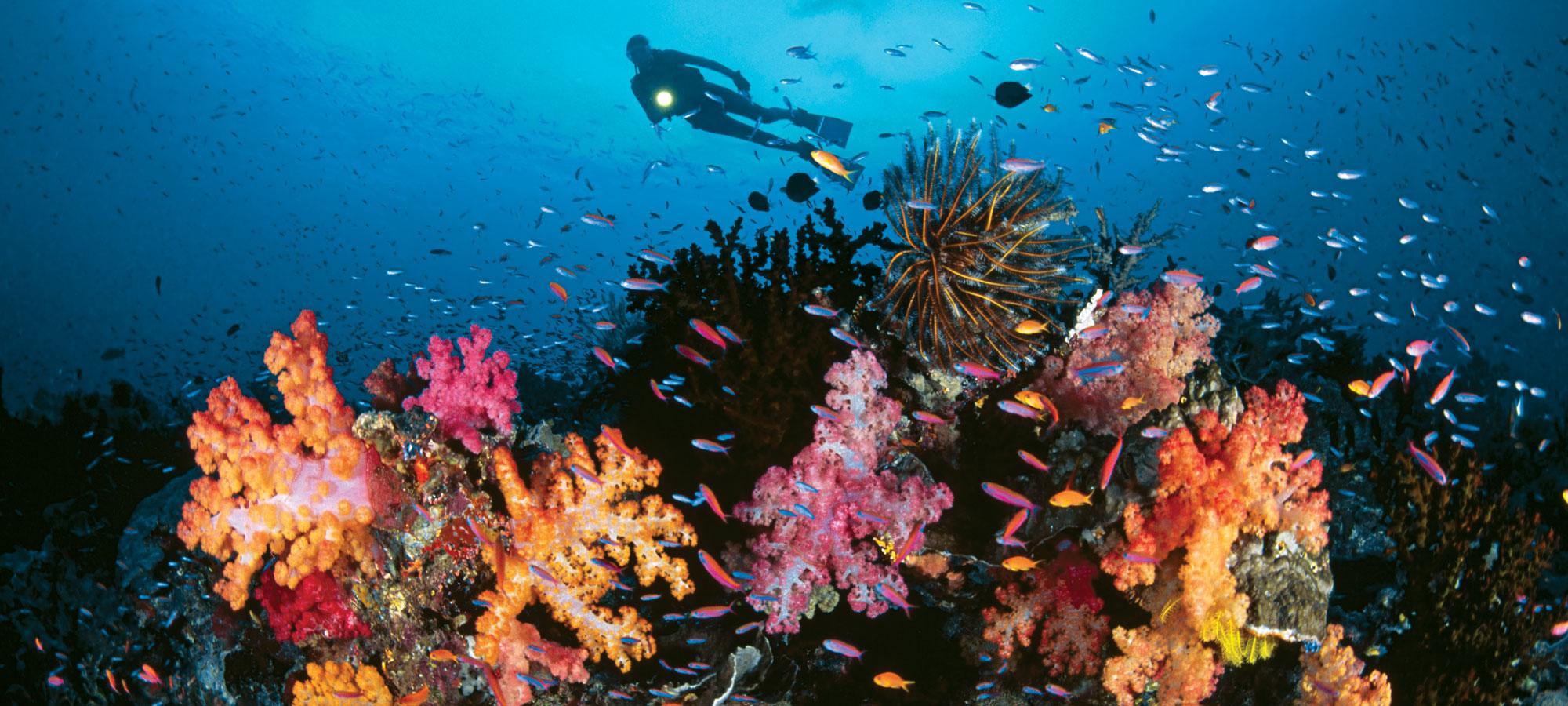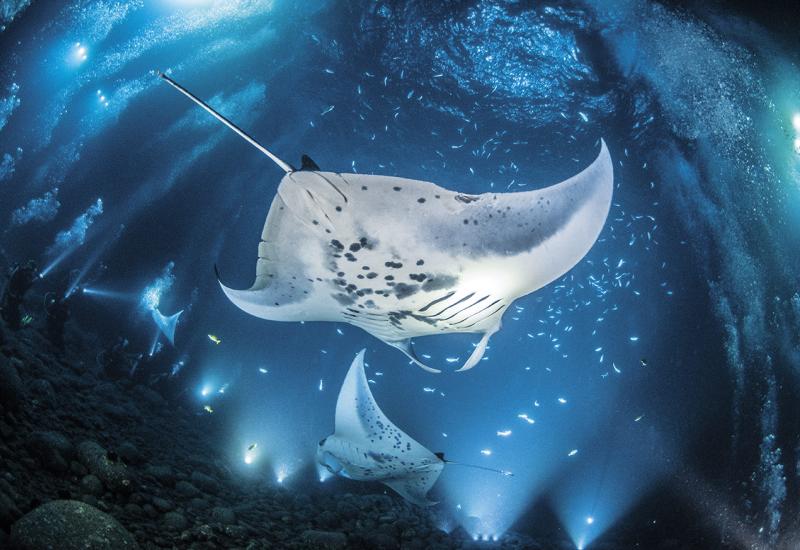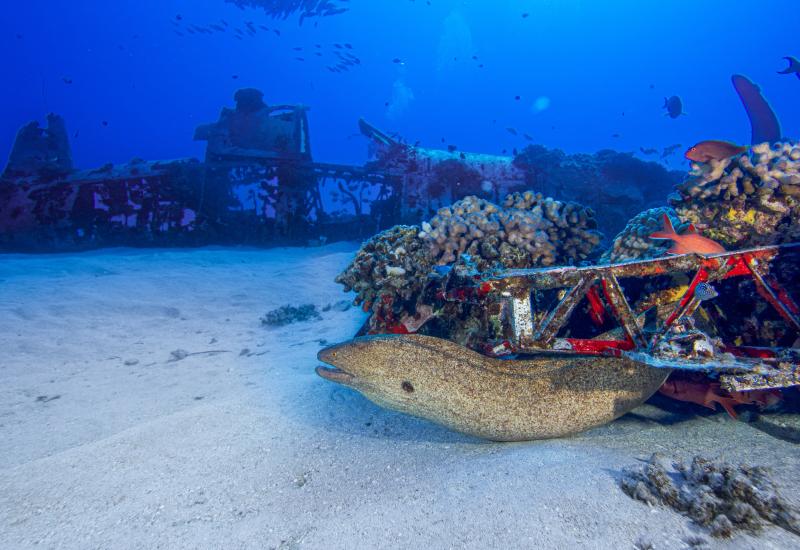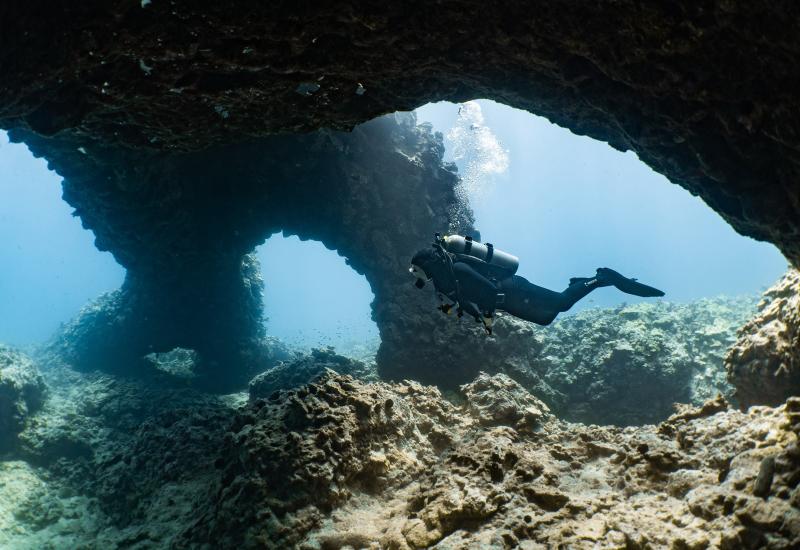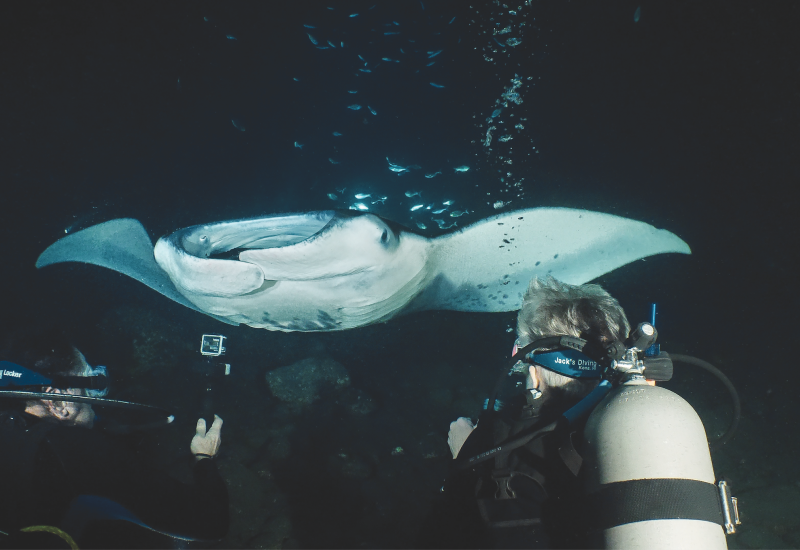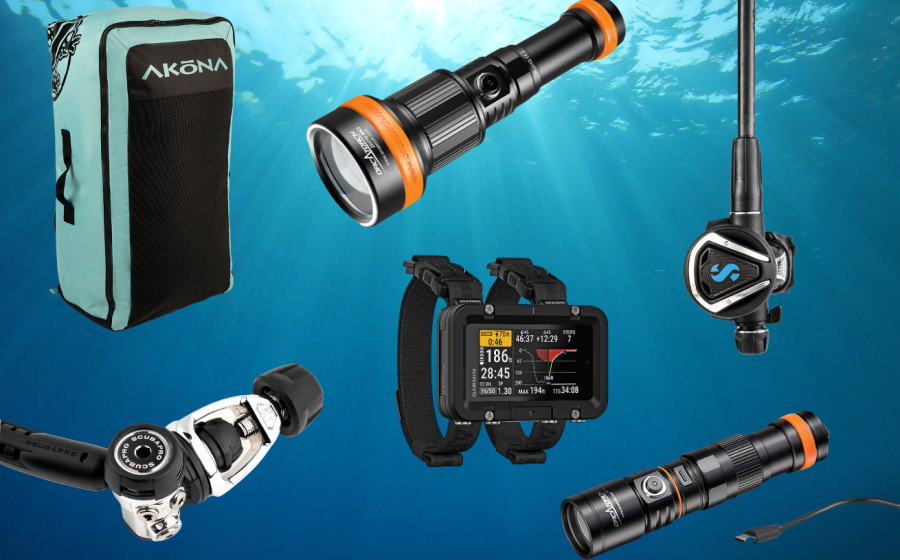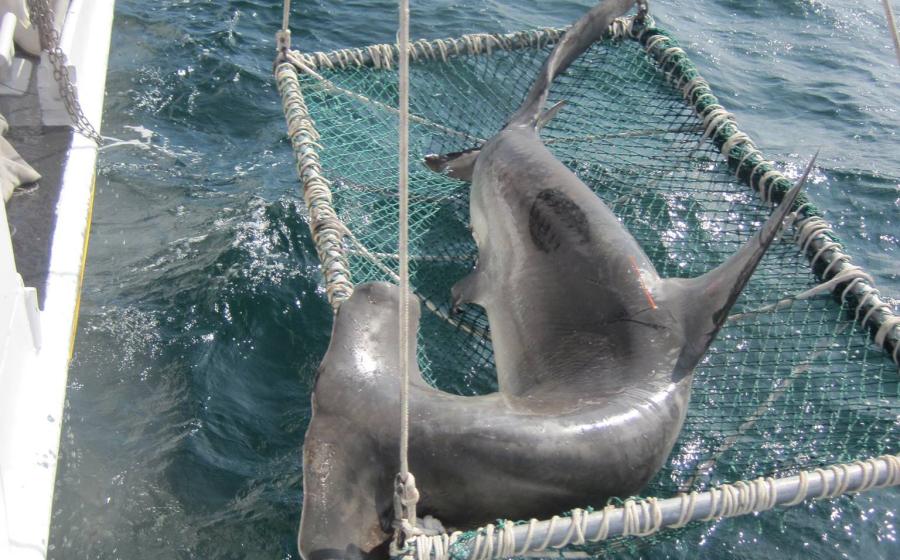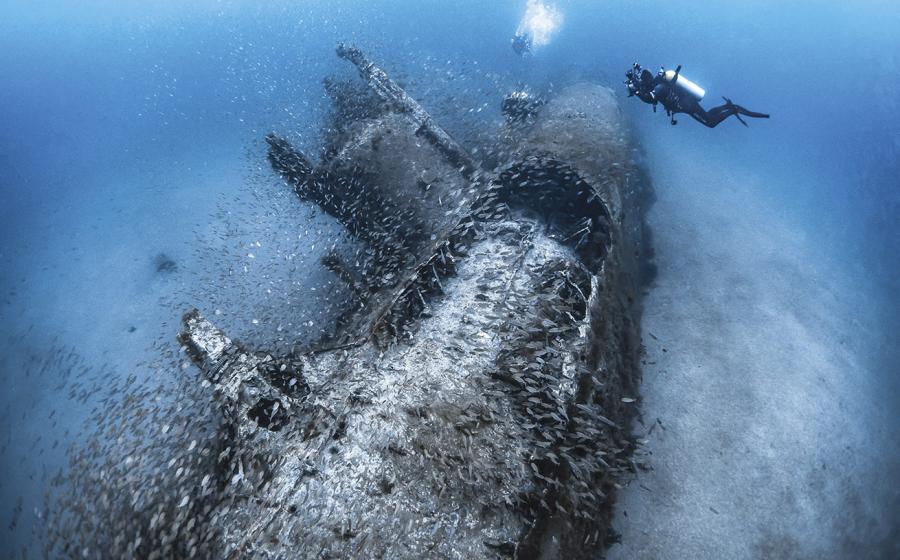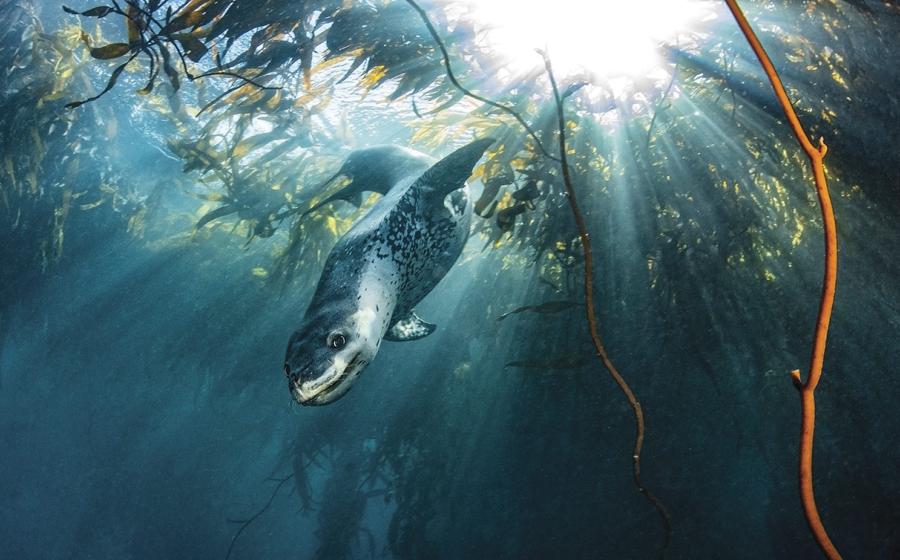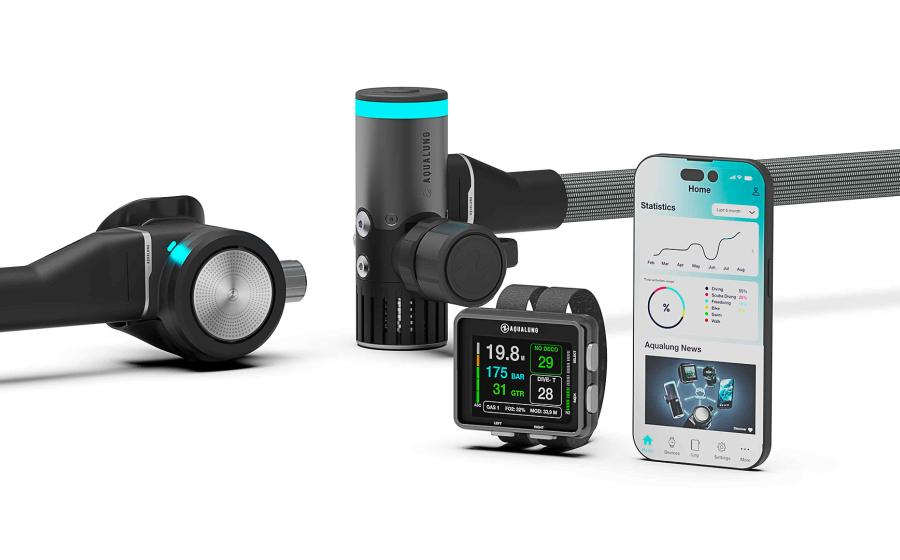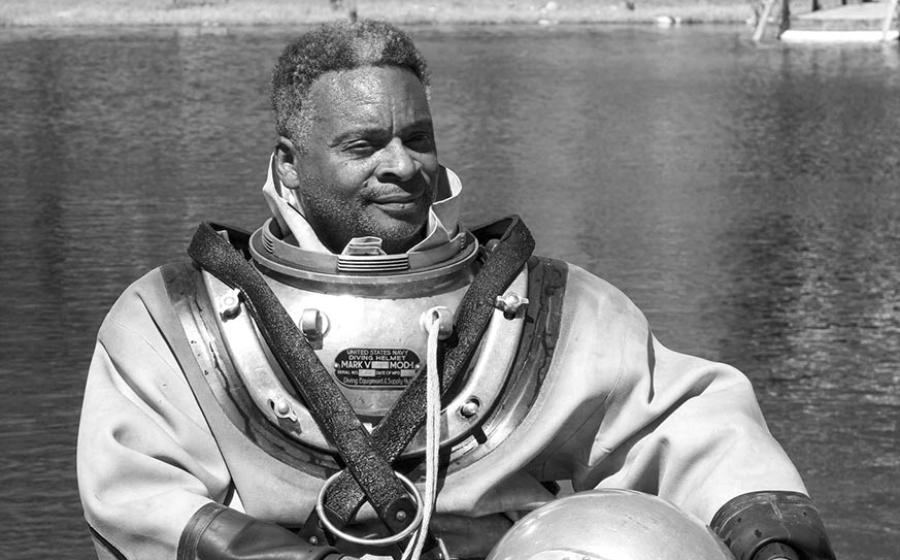The Top Nine Dive Capitals of the World
When you land and half the plane pulls fin-shaped duffels from the overhead bin. Or the seafood shack’s chalkboard boasts the day’s viz and days since the last whale shark spotting. Where locals chat about sea critters by name... not by species name, but “Victor the Viper Eel.” Or strangers crowd around a proudly shared tablet, aww-ing at a shot of a baby (octopus). Where the local watering hole barkeep responds to a “more beer” hand signal with a round-armed “OK” tap to the top of his head. If all of these things are true, you might be in a dive capital. And after reading about these nine alluring dive-centric destinations, you just might be heading to one soon.
1. Maui, Hawaii
Maui nō ka ‘oi translates to “Maui is the best,” and when it comes to Hawaiian diving, the saying fits like a second skin—or a wetsuit. Maui not only has a wealth of turtle-heavy shore dives but offers a gateway to diving the nearby islands of Lanai and, on a flat day, Molokai—try Dive Maui’s inflatable. The partially submerged volcanic crater Molokini is a must for first-timers. Visibility for days, endless opportunities to discover new critters—since more than 25 percent of Hawaii’s 7,000 known species of sea life is endemic—and being serenaded by humpback whale song during winter dives top the list of perks in this dive capital.
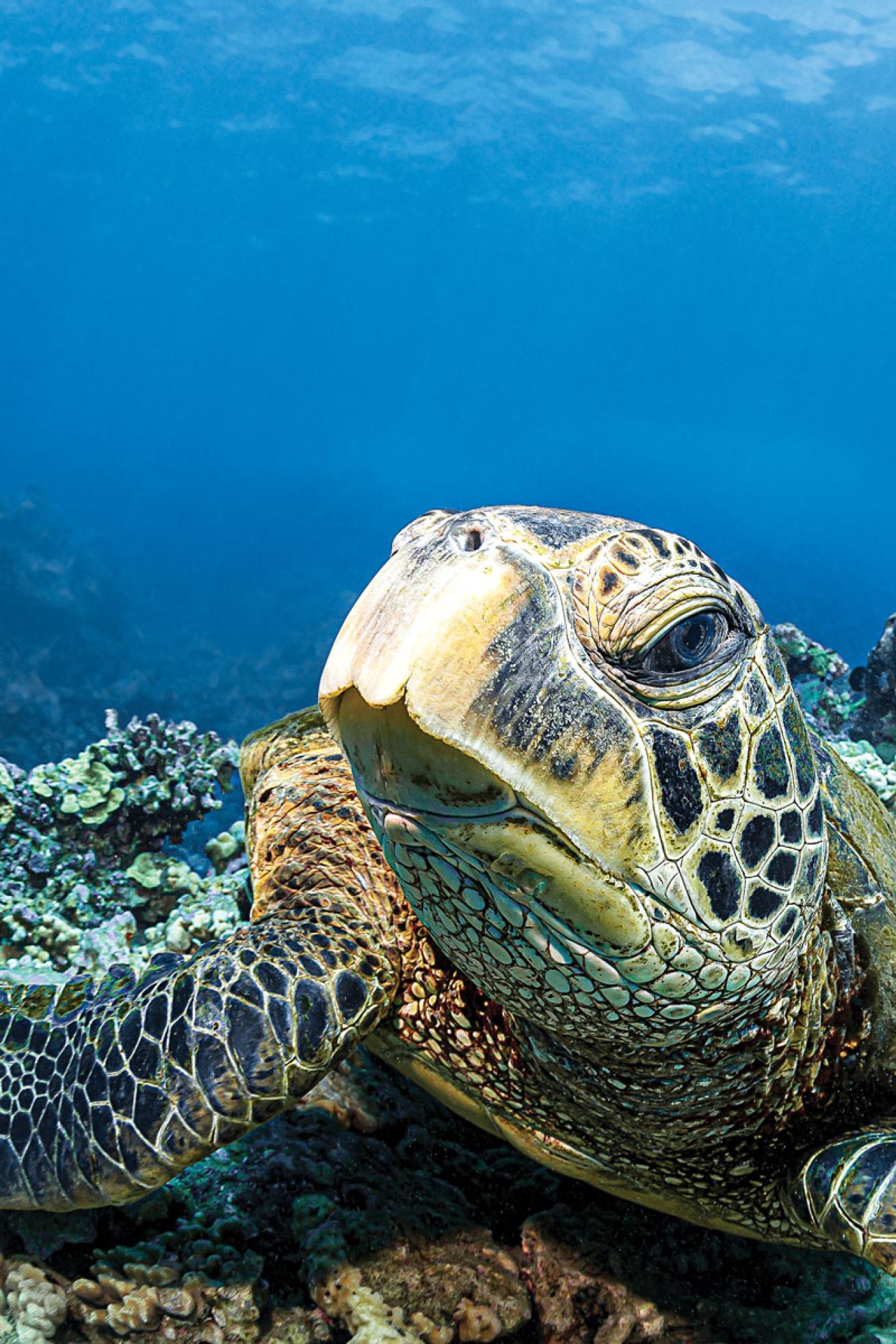
Jennifer PennerA green sea turtle mugs for the camera at Maui’s Makena Landing.
“Molokini boasts 100 to 150-plus feet of visibility, with warm water and a variety of marine life—frogfish, day octopus, harlequin shrimp—and pelagic species,” says Lisa Smith of Maui Dive Shop. “Lanai’s Cathedrals dive sites offer lava tubes, swim-throughs and chandeliers of black coral, with spinner dolphins frolicking en route. We have been seeing more whale sharks in recent years—Hawaiian monk seals are another rare treat, and there is a spot off the Maui coast where we spotted dozens of manta rays on a single dive last winter.”
When to Go: Year-round; January through March is peak humpback season.
Dive Conditions: Visibility can be 40 to 50 feet at shore sites, ranging up to 100-plus at Molokini. Water temps vary from 75 to 82 degrees F.
Unique Local: Treat Try Hawaiian shave ice—like snow cone, but the ice is shaved, not crushed—with a “snow cap” of drizzled sweet condensed cream.
Mascot: Humpback whales—easy to spot above water in winter, and maybe below if you’re very lucky.
Lost in Translation: The humuhumun-ukunukuapua’a, or reef trigger, is Hawaii’s state fish.
2. Bonaire
Bonaire’s national marine park dates to 1979, offers a total of 86 dive sites and is home to over 57 species of soft and stony coral and more than 350 recorded fish species. Besides fabulous visibility and balmy 80-degree weather, this is the land of the shore dive. Some 60-plus sites are marked with names on yellow stones adjacent to their entry points. A fleet of pickup trucks ideal for hauling tanks and gear is available for rent—or comes with your room—and easy reef-wall navigation makes this a comfortable first-guideless experience.
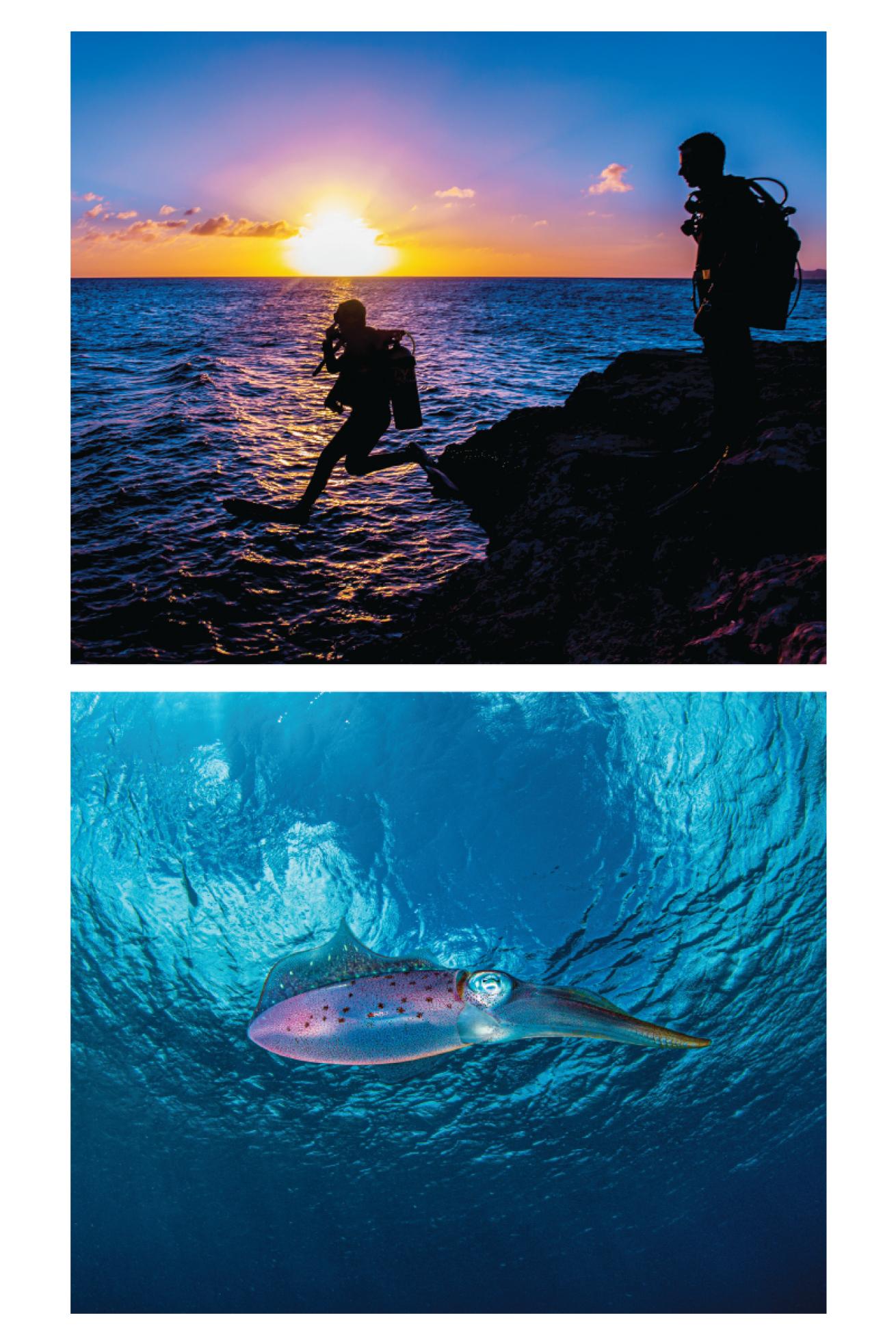
From top: Beth Watson; Natalia Barsukova/Shutterstock.comEasy-access diving and a wide variety of life, including Caribbean reef squid, make Bonaire one of a kind.
If it’s been a while since you got your fins wet, a few dives with Augusto Montbrun and his Buddy Dive Resort crew will refresh your skills during a boat dive. Klein Bonaire, a tiny, picturesque islet off the main island, offers an additional two dozen sites, great snorkeling and sandy No Name Beach—perfect for a picnic or relaxing surface interval. Abundant tropical reef fish mingle with sponge-munching sea turtles; sharp-eyed divers can spot seahorses or frogfish. If you are toting a camera, this is largely a mecca for macro.
When to Go: Diving is great year-round; May through October has fewer crowds.
Dive Conditions: Viz averages from 100 to 150 feet; water temps are 78 to 84 degrees F.
Mascot: Wild flamingos
Local Signature Treat: Cadushy Distillery’s night-blooming cactus liqueur, tart and tasty.
Lost in Translation: If someone calls you dushi, say “Danki!”— it’s a Papiamentu form of endearment, not a slam.
3. Roatan, Bay Islands of Honduras
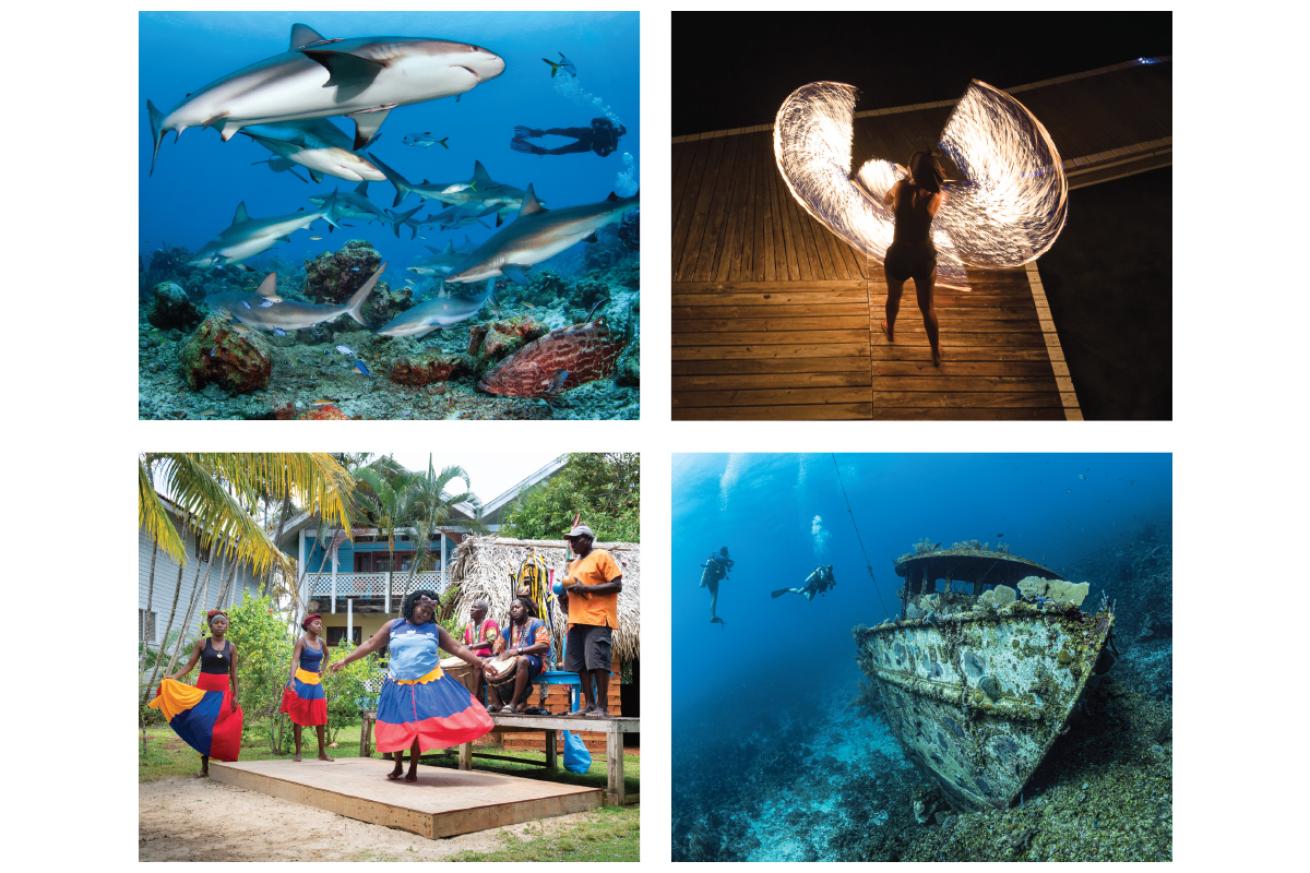
Clockwise from top left: Lureen Ferretti; Jennifer Penner; Kadu Pinheiro; Gabi C. Moreira/Shutterstock.comWrecks such as Mr. Bud, shark-filled reefs and local island culture help Roatan stand out.
Twenty years ago, Roatan was a sleepy island whose only tourists made an arduous journey toting fins and BCs to explore the second-largest reef system in the world. A booming cruise ship biz made the island more accessible, offering world-class diving just minutes from the port—dive for a day and you’ll come back for a week. The Mesoamerican Barrier Reef's 200 dive sites offer an escape from the crowd, along with the occasional hammerhead, manta ray, whale shark or sperm whale. Non-cruise divers can spice up their stay with day trips to nearby Cayos Cochinos or Utila and enjoy the come-as-salty-as-you-like casual nightlife vibe.
“Why Roatan? Crystal-clear waters with an abundance of marine life set in a tropical paradise with a huge diversity of diving, from deep drop-offs, fantastic wrecks and over 100 miles of a vibrant fringe reef surrounding the island,” says Tati Pereira-Hughes, PADI course director at Anthony’s Key Resort. “The site called Texas is my favorite—the north current meets west at that point, producing awesome current with schools of fish, enormous diver-size barrel sponges and very healthy coral.”
When to Go: Year-round; October and November can be rainy, with storms affecting viz; July and August are steamy.
Dive Conditions: Visibility ranges from 70 to 110 feet; water temps from 78 degrees to 82 degrees F.
Dry Day: You’ll have West Bay Beach all to yourself for an afternoon swim after the cruise ships leave.
Signature Local Treat: Monkey LaLa, a decadent mudslide-meets-piña colada, is the island’s signature cocktail.
Locals Only: Only accessible during the best weather, the Cayos Cochino seamounts rise thousands of feet to just short of the surface.
4. Cairns, Australia
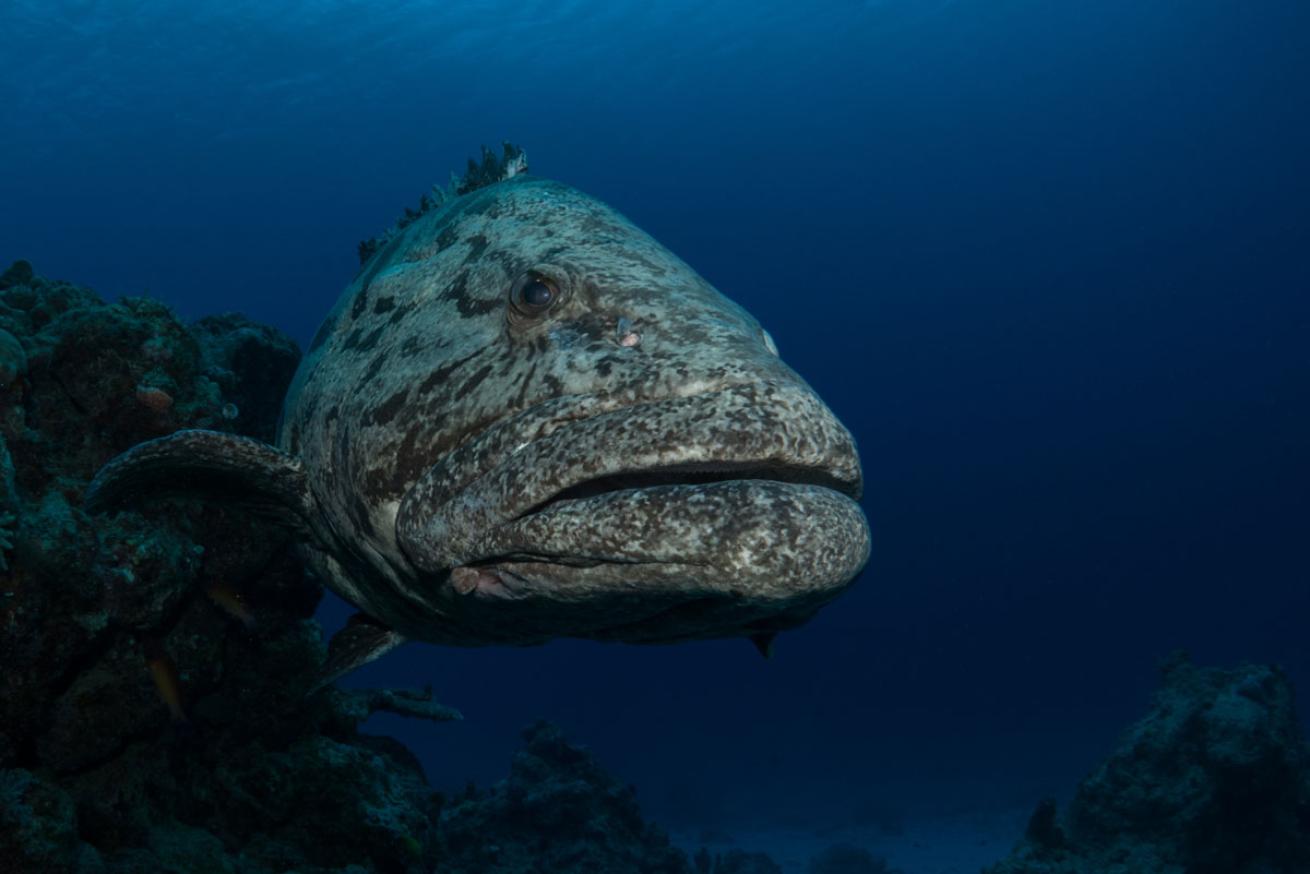
ShutterstockDiver-size potato grouper.
“Cairns is often referred to as the gateway to the Great Barrier Reef for a reason. Visitors are spoilt for choice between day boats, snorkeling, islands and myriad other watersports, as well as adventure diving, which is what we are all about,” says Bridgette Gower of Mike Ball Dive Expeditions.
Home to more than 1,500 fish species, 400 types of hard coral, one-third of the world’s soft corals, over 130 species of sharks and rays, six of the world’s seven species of marine turtles and 30 species of whale and marine mammals, including the vulnerable manatee-like dugong—you can’t go wrong diving the world’s most famous reef.
While day boats are popular, a multiday trip on a liveaboard offers access to the outer reef and Coral Sea, with excellent sites like Steve’s Bommie showcasing a staggering array of biodiversity.
Cuttlefish, hammerhead sharks, lacy scorpionfish, ghost pipefish, mantis shrimp and pygmy seahorses are a few unexpected critters to try and spot. North Horn at Osprey Reef is legendary as a shark dive and for walls awash in soft coral.
When to Go: Year-round; October through December is peak season; June and July are dwarf minke whale season.
Dive Conditions: Visibility is 60 to 90 feet; water temps range from 75 to 84 degrees F.
Locals Only: Moore Reef’s annual coral spawn night dive: Soft corals and stony corals simultaneously spawn one to six days after the full moon in October.
Mascot: The sea snake; Cairns is home to 14 to 17 species of these fascinating creatures with a 30 million-year heritage. Spot them on the reef, free swimming or sunning themselves at the surface.
Prove It: Diver-size potato grouper will happily snuggle in and pose for pics at Cod Hole.
5. Gili Islands, Indonesia
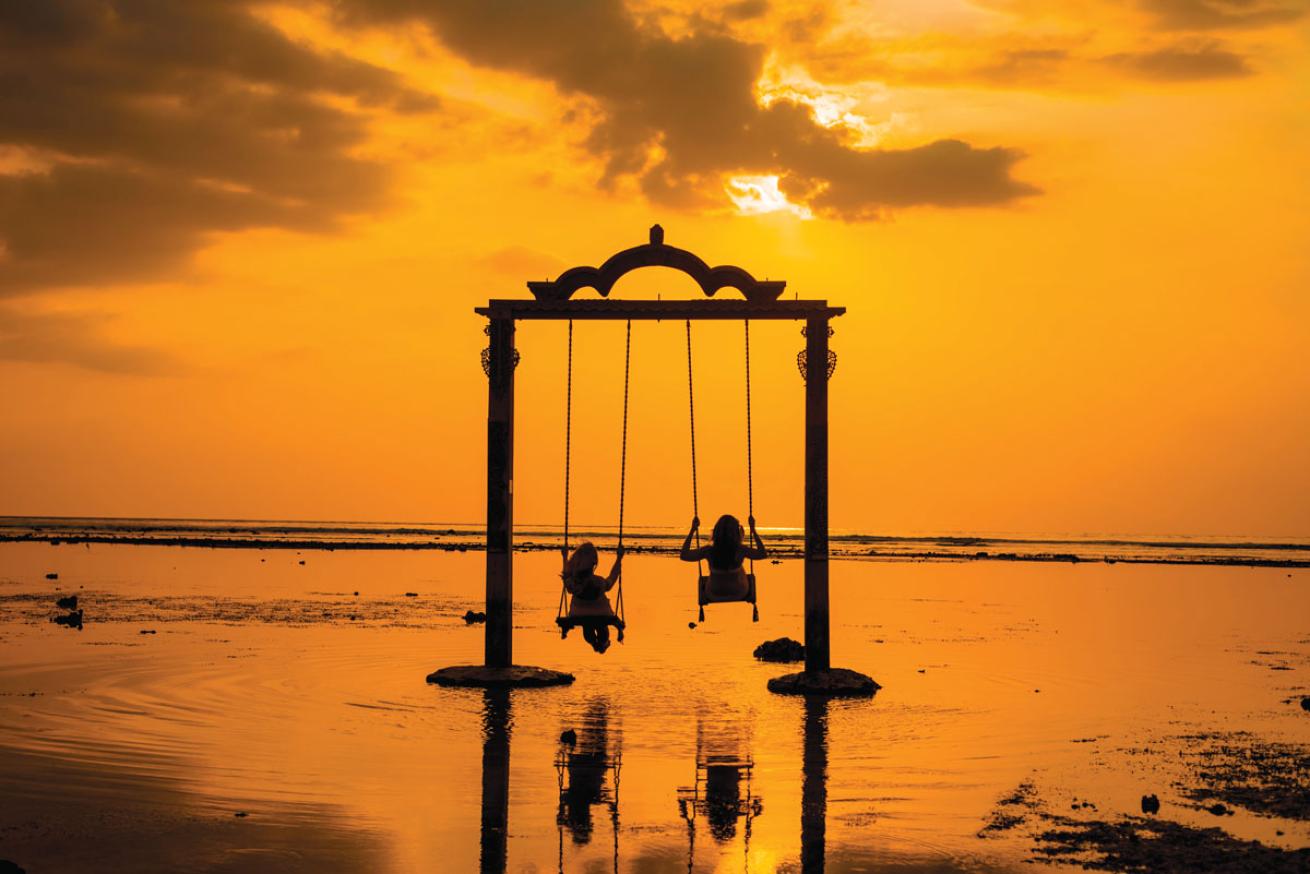
Iunewind/Shutterstock.comGili Trawangan’s Datu Swing.
The Goldilocks of dive destinations, Indonesia’s Gili Islands offer an experience for every speed of bubble blower. Gili Trawangan, Gili Meno and Gili Air each lie ensconced in palm-dotted, golden shores that give way to vibrant offshore coral reefs, yet each boasts its own unique energy. “Gili T” is an Insta-worthy backpacker hotspot with a bustling social scene; tiny Gili Meno exudes escape and romance; and Gili Air offers a happy medium.
“What makes Gili T ideal is the combination of easy diving and beachy island life,” says Estela Fernandez Pastor of Villa Almarik Resort and Spa. “Chat about the day’s ghost pipefish or whitetip reef shark spotting at happy hour—none of the islands allows motor vehicles, so no Uber needed—or try your hand at sepak takraw, a cross between volleyball and soccer.”
When to Go: Year-round; visibility drops December through March due to plankton.
Dive Conditions: Viz ranges from 35 to 120 feet, water temps from 81 to 90 degrees F.
Mascot: Hawksbill sea turtles are endangered but easy to spot on the sponge-rich reef fronting Villa Almarik.
Prove It: Datu Swing, an over-ocean swing on Gili T, is so photographed it has become a symbol of the island itself.
Unique Cert: Fish ID—with over twice the species of the Great Barrier Reef, the Coral Triangle takes this cert to the next level.
6. Little Cayman, Cayman Islands
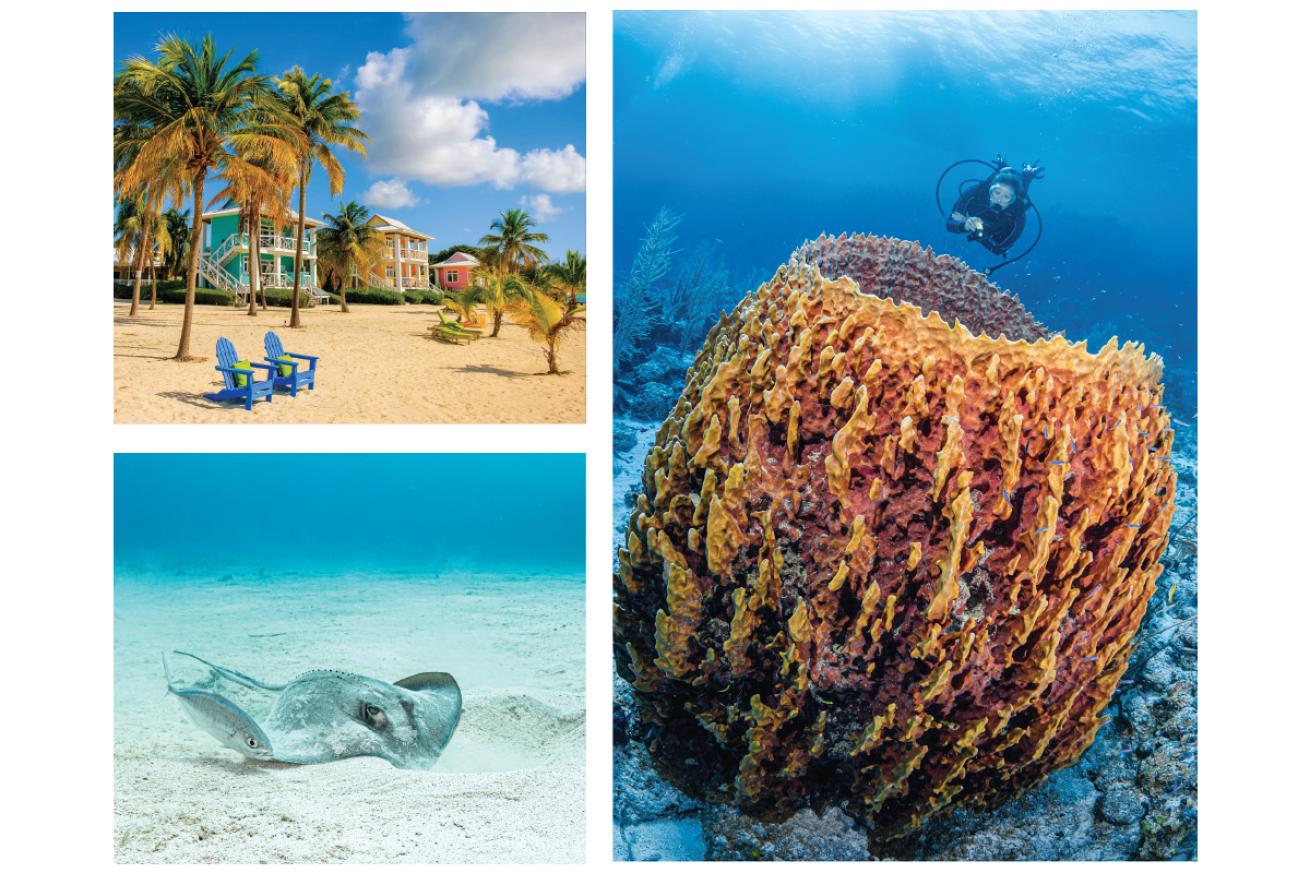
Clockwise from top left: Sandarina/Shutterstock.com; Jason Sintek; Mady Macdonald/Shutterstock.comDivers enjoy the quiet beaches, huge barrel sponges and resident stingrays of Little Cayman.
Considering that the International Scuba Diving Hall of Fame is about to celebrate its 20th anniversary in the Cayman Islands, it’s no surprise that one of Cayman’s most charming communities made our list of dive capitals. Intimate, diver-welcoming resorts greet visitors right from the runway in this Caribbean paradise. Unpretentious and quaint, Little Cayman is home to 200 residents—and several times that number in iguanas.
It’s ringed by pristine white-sand beaches, embraced on the northwest by the Bloody Bay Marine Park, with occasionally kayakable sand spit Owen Island on the south.
“Although Little Cayman is charmingly small and not very developed, the most beautiful parts of the island are underwater,” says Madison Lortie, a research diver working with Little Cayman’s Central Caribbean Marine Institute. “The reefs are in a good state compared to much of the Caribbean and the rest of the world—Cumber’s Caves, Mixing Bowl and Eagle Ray Roundup are faves. Night diving is especially memorable—the island has barely any light pollution, so coming up, the stars are spectacular.”
When to Go: November to August; the island clears out for much of September and October, which is storm season.
Dive Conditions: Visibility can reach 100-plus feet; water temps are 78 to 86 degrees.
Dry Day: Bike the entire 10-square-mile island, starting at Point of Sand dock for sunrise, with a stop to go geocaching. Wrap up at Little Cayman Beach Resort for karaoke.
Signature Local Treat: “Heavy cake,” aka a dense cassava and coconut spice cake; try it at island hotspot the Hungry Iguana on holidays and special occasions.
Lost in Translation: Bobo (pronounced boh-boh) is another word for a close personal friend.
7. Koh Tao, Thailand
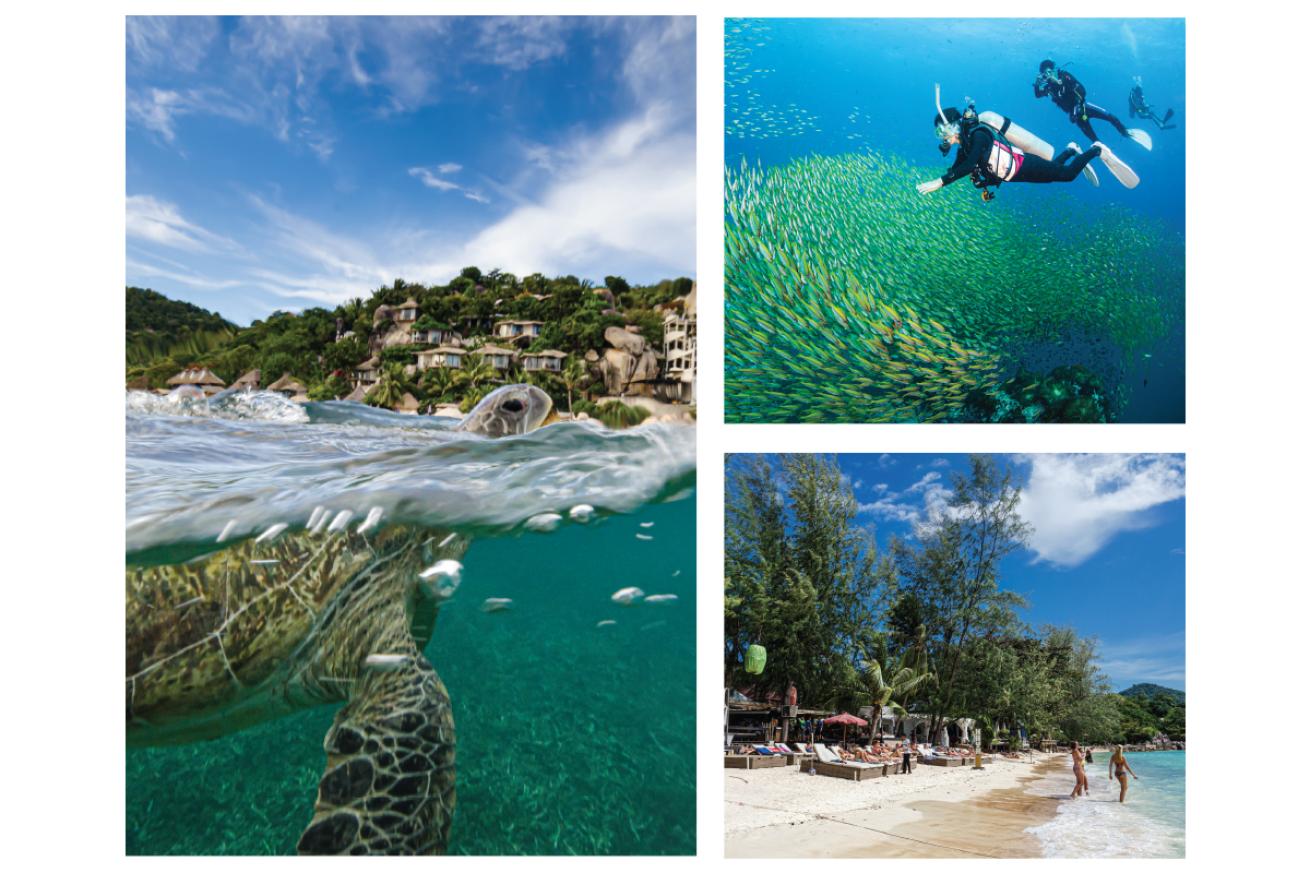
Alex TyrrellBeautiful views, beaches and dive sites make Koh Tao a tropical paradise for travelers.
A staple on the backpacker trail for Open Water certs, Thailand’s affordability draws new blood in droves.
The hottest Thai destination seems to change on a yearly basis, but one of the most established—and slightly less chaotic party-isle options—is Koh Tao. “Turtle Island” is so named for its jungle-foliage-covered granite mound shape bordered by deeper water, allowing silt and sediment to sink for improved visibility.
Uninhabited until the 1980s, the island welcomes rather than tolerates scuba divers. Instructors at PADI Five Star IDC Coral Grand Divers, on the beach on the northern part of Sairee Beach, are quick to boast of their island's charms.
“Koh Tao is one of the world’s leading dive destinations for good reason; the diving is beautiful and convenient, with sites as close as five minutes away. We get to dive with turtles, whale sharks and a multitude of beautiful fish that make diving on Koh Tao a pleasure for all levels,” says Coral Grand’s Pollakorn Srisung.
When to Go: March to May is the best time to spot whale sharks; the island monsoon season (November through January) is opposite the rest of Thailand.
Dive Conditions: Viz can range from 35 to 70 feet; water temps from 80 to 85 degrees F.
Unique Cert: Whale Shark Awareness; the fish are spotted throughout the year at deeper dive sites like Chumphon Pinnacle, and occasionally in more moderate depths.
Dry Day: For a traditional Thai massage, try Watergate Spa; its ocean view alone is an antidote to toting tanks.
Lost in Translation: If a local asks, “Sanuk mai?” (Are you having fun?) respond with a reassuring “Sanuk” or you might be subject to great efforts to help you regain your happy vibe.
8. Cozumel, Mexico
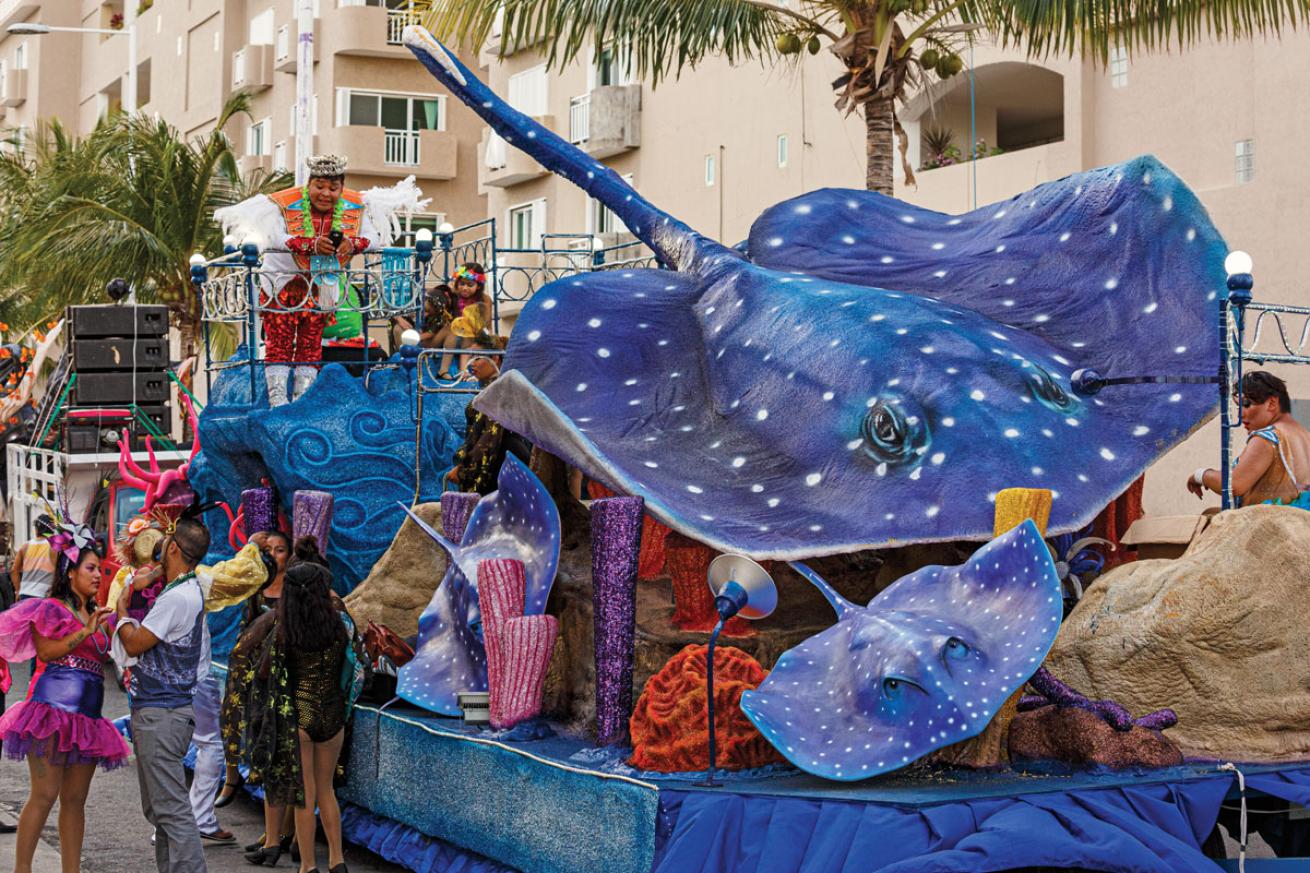
Lureen FerrettiThe ocean is at the center of Cozumel's culture.
Long famous for its drift diving, Cozumel’s whipping current, which creates a relaxing, go-with-the-flow experience for divers, also keeps the reef clean and healthy. Sites range from shallow reefs teeming with marine life to sheer vertical walls and finger channels, a fave hang for reef sharks and green morays; deep reefs with swim-throughs and drop-offs entice advanced divers.
“Excellent marine life, vibrant corals and exceptional visibility all combine to make Cozumel one of the top dive destinations in the world,” says Al Bay of Bay Adventures. “It’s a friendly, welcoming and safe place to visit. It’s hard to find another destination that compares.”
Affordability is a big factor in what makes Coz a dive capital—spending half the pesos means double the dive trips! Easy access through Cancun and low fares on high-speed ferries to the island give a great budget alternative to spendy direct flights.
When to Go: November to May; the island can be crowded during school holiday periods.
Dive Conditions: Visibility of 100-plus feet, with water temperatures at 82 to 90 degrees.
Dry Day: Volunteer with the local sea turtle rescue, either relocating nests or helping clear hatchlings’ paths to the water.
Local Treat: Traditional Mayan hot chocolate, a rich cayenne and cinnamon-spiked beverage; taste test and grind your own at Kaokao Factory workshop.
9. Key Largo, Florida
This key just an hour or so south of Miami or Fort Lauderdale airports offers big bang for the diving buck and a convenient no-passport-needed way to dip fins in fish-heavy seas. Amazing shallow reefs and wrecks filled with tropical fish are matched by marquee wrecks that reach depths from 180 to 320 feet, attracting a fair number of technical divers and metal heads.
Nearly all sites are boat dives, most 3 to 5 miles offshore, with 15 shops servicing divers of all experience levels. The Gulf Stream keeps the reef clean, offering great ops to see black grouper, eels, queen angels, lobsters, nurse sharks, eagle rays and turtles heading toward their nesting sites in the summer.
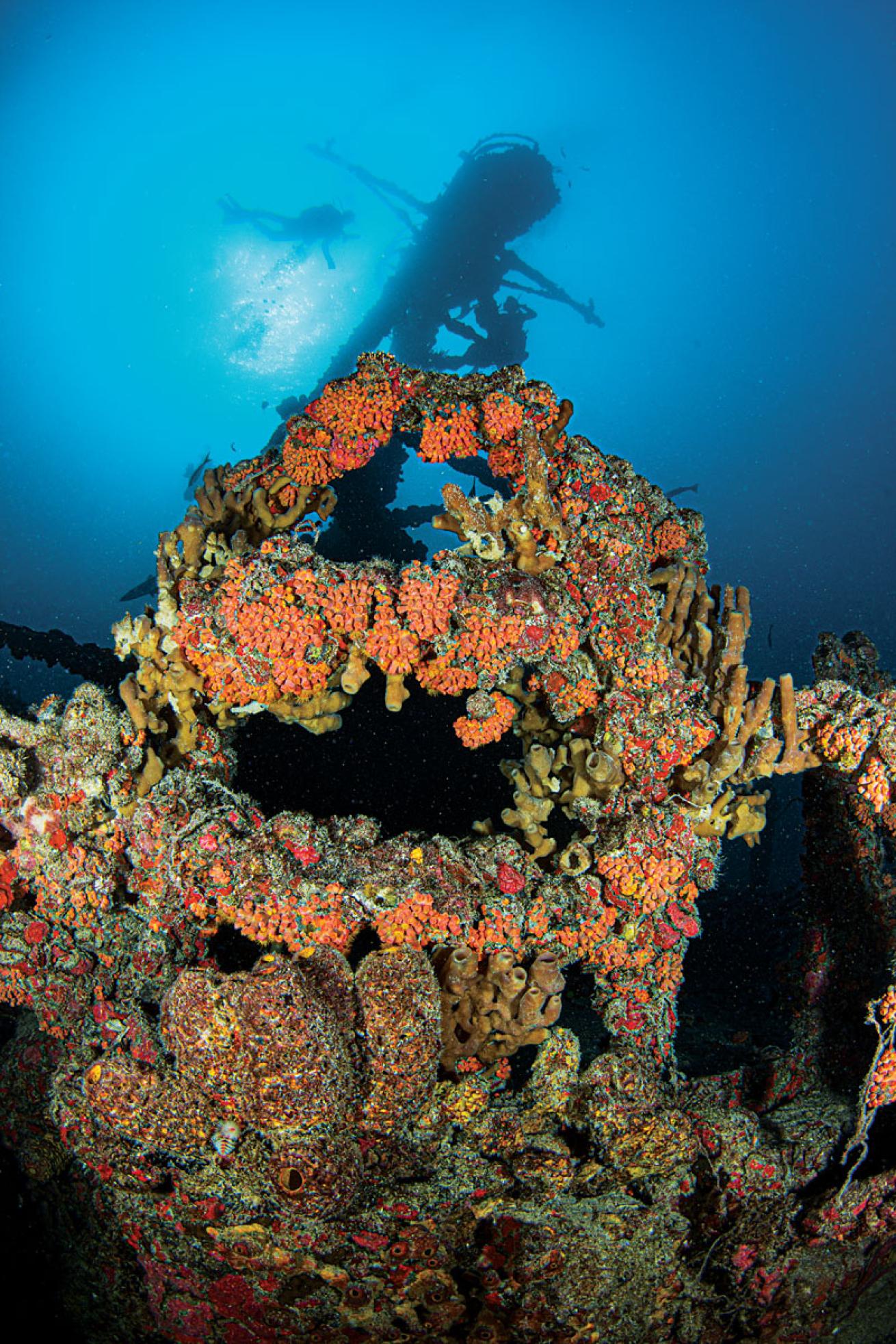
Brandon ColeThe Spiegel Grove is a magnet for wreck lovers in Key Largo.
“Our reefs are 15 to 50 feet—great for snorkelers, beginner divers, inexperienced divers or just people who want the bottom time. You can do four hours of diving on the reef without much of a surface interval,” says Dan Dawson of Horizon Divers.
“Our reef system is ideal for families and mixed-experience groups. We’ll have rec divers doing their two-tank off the same boat as a tec diver doing one long or deep dive; meanwhile a couple of snorkelers can check out the shallow end of a reef or wreck,” says Dawson.
When to Go: Year-round, although the water can be positively toasty in summer.
Dive Conditions: Viz averages 40 to 60 feet on local inner reefs, 60 to 100 feet on the outer reef ledge. Temps vary from 72 to 87 degrees F.
Mascot: The barracuda. You can see 100 barracuda offshore as you giant stride into the water.
Unique Certs: Key Largo is a great place to get rebreather certified—tec is an established niche here.
Signature Local Treat: Keep your eye out for chocolate-dipped Key lime pie on a stick, available at outlets from gas stations to local restaurants.

